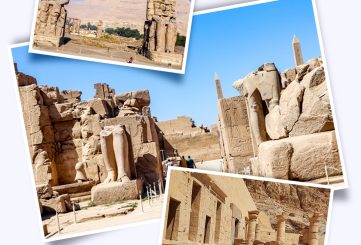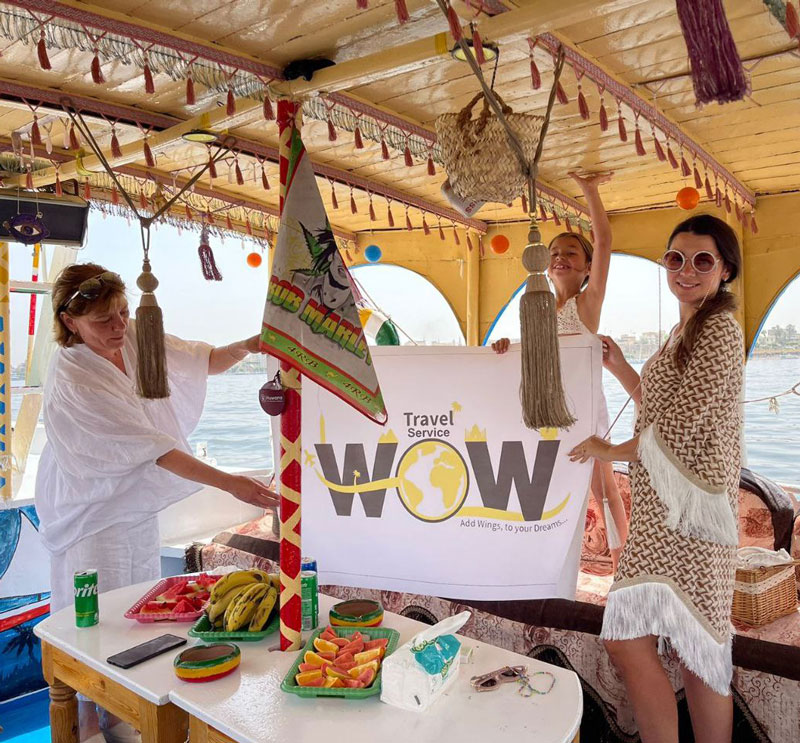Luxor + Valley of the queens from Marsa Alam
- $95 for ages 13 and above
- $50 for children aged 6-12
- Free for children under 6
- Transfer from the hotel around 4:00 am, depending on the hotel's location.
- City of the Living: Visit to the Karnak Temple Complex (scarab beetle statue, sacred lake).
- Boat trip to the other bank of the Nile.
- Lunch at a restaurant overlooking the river (buffet style).
- Colossi of Memnon, Valley of the Queens, visit to the Temple of Queen Hatshepsut.
- Optional boat trip to Banana Island (booked with the guide).
- Stone carving factory / perfume factory.
- Transfer to Marsa Alam, arrival at the hotel around 10:00 pm, depending on the hotel's location.
*The order of activities may change depending on the flow of tourists.
- Water, packed breakfast from the hotel or snacks.
- Headgear.
- Sunglasses.
- Sunscreen.
- Comfortable shoes.
- Warm clothing in winter months.
- Money for personal expenses.
Included:
- Transportation service.
- Transfer in a modern tourist bus with air conditioning and a toilet.
- Guide - egyptologist.
- Entrance tickets to all mentioned attractions.
- Lunch at a restaurant.
Not included:
- Additional expenses not included in the program.
- Drinks at the restaurant.
- Boat trip to Banana Island - $10.
Luxor is rightfully considered the largest open-air museum, and its name comes from the Arabic “Al-Uqsur,” which means “palaces.” The Nile River divides the city into two parts: the right (eastern) bank, known as the “City of the Living,” and the left (western) bank, known as the “City of the Dead.”
We offer various excursion programs that include the most interesting sights, but it is impossible to cover everything within the standard group tours. For those who want to see more, we organize individual excursions in Luxor.
The Karnak Temple Complex covers an area of 1.5 km by 700 m. Construction of the complex began in the 20th century BCE and lasted for 13 centuries. Karnak is the only temple consisting of 10 halls and having 10 gates (pylons). The statue of the scarab beetle, which according to legend grants wishes, and the sacred lake measuring 129 x 77 m, formerly used for ritual bathing, usually attract special interest on excursions. A sacred path represented by an alley of sphinxes connects the Karnak Temple Complex to the Luxor Temple.
The Colossi of Memnon are the only remaining reminders of the temple of Amenhotep III, built around 1400 BCE. The temple was completely destroyed by an earthquake around 1200 BCE, but the colossi have survived. Another strong earthquake in the 27th century BCE partially destroyed the left statue, and at sunrise, the colossus began to “sing.” However, after the restoration of the colossus in 199 CE, the singing ceased.
In the Valley of the Queens, the wives and children of pharaohs, as well as some notable individuals of that time, were buried. Burials took place between 1550 and 1070 BCE. Approximately 80 tombs have been discovered, some of which remain unidentified. The tomb of Nefertari is of particular interest, with its rock drawings depicting the history of Egypt.
The Temple of Queen Hatshepsut was built between 1482 and 1473 BCE. The ancient name of the temple, Djeser-Djeseru, translates to “Holiest of Holies.” The temple of the female pharaoh was a place of pilgrimage where people left requests for help or healing from diseases on the walls.
The stone carving factory (alabaster factory) partly resembles a museum. During the visit, you will learn about the technology of producing alabaster products and find out how genuine alabaster items differ from imitations. If desired, you can purchase souvenirs made of authentic stone.
During the visit to the perfume factory, the guide will explain the techniques of oil and perfume production. At the factory’s shop, you can buy high-quality oils and oil-based perfumes.







